
A column or pillar in architecture and structural engineering is a structural element that transmits, through compression, the weight of the structure above to other structural elements below. In other words, a column is a compression member. The term column applies especially to a large round support with a capital and a base or pedestal, which is made of stone, or appearing to be so. A small wooden or metal support is typically called a post. Supports with a rectangular or other non-round section are usually called piers.
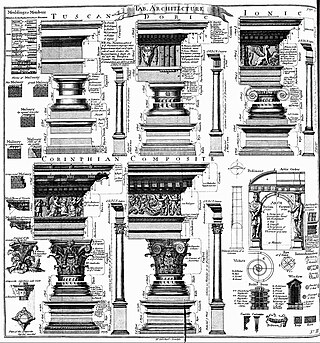
An order in architecture is a certain assemblage of parts subject to uniform established proportions, regulated by the office that each part has to perform. Coming down to the present from Ancient Greek and Ancient Roman civilization, the architectural orders are the styles of classical architecture, each distinguished by its proportions and characteristic profiles and details, and most readily recognizable by the type of column employed. The three orders of architecture—the Doric, Ionic, and Corinthian—originated in Greece. To these the Romans added, in practice if not in name, the Tuscan, which they made simpler than Doric, and the Composite, which was more ornamental than the Corinthian. The architectural order of a classical building is akin to the mode or key of classical music; the grammar or rhetoric of a written composition. It is established by certain modules like the intervals of music, and it raises certain expectations in an audience attuned to its language.

The Doric order was one of the three orders of ancient Greek and later Roman architecture; the other two canonical orders were the Ionic and the Corinthian. The Doric is most easily recognized by the simple circular capitals at the top of columns. Originating in the western Doric region of Greece, it is the earliest and, in its essence, the simplest of the orders, though still with complex details in the entablature above.

In architecture, a corbel is a structural piece of stone, wood or metal jutting from a wall to carry a superincumbent weight, a type of bracket. A corbel is a solid piece of material in the wall, whereas a console is a piece applied to the structure. A piece of timber projecting in the same way was called a "tassel" or a "bragger" in England.
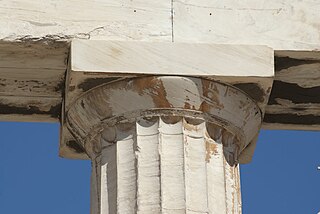
In architecture the capital or chapiter forms the topmost member of a column. It mediates between the column and the load thrusting down upon it, broadening the area of the column's supporting surface. The capital, projecting on each side as it rises to support the abacus, joins the usually square abacus and the usually circular shaft of the column. The capital may be convex, as in the Doric order; concave, as in the inverted bell of the Corinthian order; or scrolling out, as in the Ionic order. These form the three principal types on which all capitals in the classical tradition are based. The Composite order established in the 16th century on a hint from the Arch of Titus, adds Ionic volutes to Corinthian acanthus leaves.
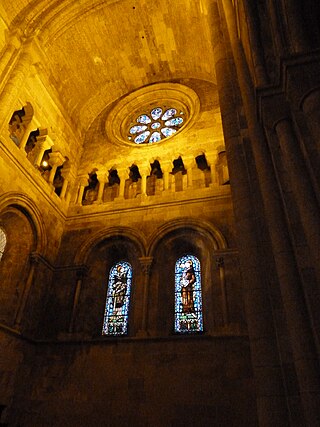
A triforium is an interior gallery, opening onto the tall central space of a building at an upper level. In a church, it opens onto the nave from above the side aisles; it may occur at the level of the clerestory windows, or it may be located as a separate level below the clerestory. Masonry triforia are generally vaulted and separated from the central space by arcades. Early triforia were often wide and spacious, but later ones tend to be shallow, within the thickness of an inner wall, and may be blind arcades not wide enough to walk along. The outer wall of the triforium may itself have windows, or it may be solid stone. A narrow triforium may also be called a "blind-storey", and looks like a row of window frames.

An entablature is the superstructure of moldings and bands which lies horizontally above columns, resting on their capitals. Entablatures are major elements of classical architecture, and are commonly divided into the architrave, the frieze, and the cornice. The Greek and Roman temples are believed to be based on wooden structures, the design transition from wooden to stone structures being called petrification.
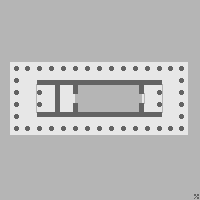
A cella or naos is the inner chamber of an ancient Greek or Roman temple in classical antiquity. Its enclosure within walls has given rise to extended meanings, of a hermit's or monk's cell, and since the 17th century, of a biological cell in plants or animals.

Moulding, or molding, also coving, is a strip of material with various profiles used to cover transitions between surfaces or for decoration. It is traditionally made from solid milled wood or plaster, but may be of plastic or reformed wood. In classical architecture and sculpture, the moulding is often carved in marble or other stones. In historic architecture, and some expensive modern buildings, it may be formed in place with plaster.
In classical architecture, a tambour is the inverted bell of the Corinthian capital around which are carved acanthus leaves for decoration.

Triglyph is an architectural term for the vertically channeled tablets of the Doric frieze in classical architecture, so called because of the angular channels in them. The rectangular recessed spaces between the triglyphs on a Doric frieze are called metopes. The raised spaces between the channels themselves are called femur in Latin or meros in Greek. In the strict tradition of classical architecture, a set of guttae, the six triangular "pegs" below, always go with a triglyph above, and the pair of features are only found in entablatures of buildings using the Doric order. The absence of the pair effectively converts a building from being in the Doric order to being in the Tuscan order.

In classical architecture, amphiprostyle denotes an ancient temple with a portico both at the front and the rear, where the columns on the narrow sides are not between antae. The number of columns rarely exceeded four in the front and four in the rear. The best-known example is the tetrastyle small Temple of Athena Nike at Athens. Other known examples are the Temple of Artemis Agrotera outside Athens, and the hexastyle Temple of the Athenians at Delos.
Philon, Athenian architect of the 4th century BC, is known as the planner of two important works: the portico of twelve Doric columns to the great Hall of the Mysteries at Eleusis and, under the administration of Lycurgus, an arsenal at Athens. Of the last we have exact knowledge from an inscription. E. A. Gardner observes that it "is perhaps known to us more in detail than any other lost monument of antiquity." It was to hold the rigging of the galleys; and was so contrived that all its contents were visible from a central hall, and so liable to the inspection of the Athenian democracy. He is known to have written books on the Athenian arsenal and on the proportions of temple buildings, but these are now lost.
Trachelium is the term in architecture given to the neck of the capital of the Doric and Ionic orders. In the Greek Doric capital it is the space between the annulets of the echinus and the grooves, which marked the junction of the shaft and capital.
This page is a glossary of architecture.

A cavetto is a concave moulding with a regular curved profile that is part of a circle, widely used in architecture as well as furniture, picture frames, metalwork and other decorative arts. In describing vessels and similar shapes in pottery, metalwork and related fields, "cavetto" may be used of a variety of concave curves running round objects. The word comes from Italian, as a diminutive of cave, from the Latin for "hollow". A vernacular alternative is "cove", most often used where interior walls curve at the top to make a transition to the roof, or for "upside down" cavettos at the bases of elements.

An annulet is a small square component in the Doric capital, under the quarter-round. It is also called a fillet or listel, although fillet and listel are also more general terms for a narrow band or strip, such as the ridge between flutes.

In architecture, a spur is the ornament carved on the angles of the base of early columns.
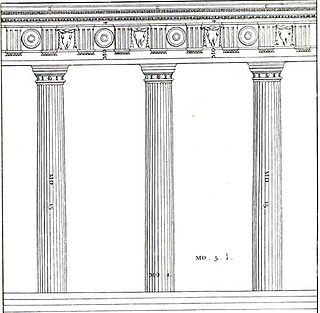
In architecture, intercolumniation is the proportional spacing between columns in a colonnade, often expressed as a multiple of the column diameter as measured at the bottom of the shaft. In Classical, Renaissance, and Baroque architecture, intercolumniation was determined by a system described by the first-century BC Roman architect Vitruvius. Vitruvius named five systems of intercolumniation, and warned that when columns are placed three column-diameters or more apart, stone architraves break. According to Vitruvius, the Hellenistic architect Hermogenes formulated these proportions ("symmetriae") and perfected the Eustyle arrangement, which has an enlarged bay in the center of the façade.

Fluting in architecture and the decorative arts consists of shallow grooves running along a surface. The term typically refers to the curved grooves (flutes) running vertically on a column shaft or a pilaster, but is not restricted to those two applications. If the hollowing out of material meets in a point, the point is called an arris. If the raised ridge between two flutes is blunt, the ridge is a fillet.
















